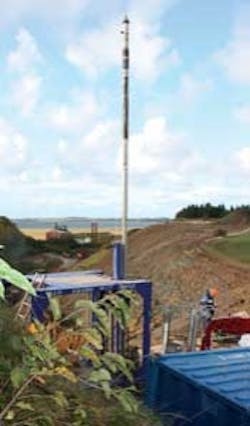Recent testing of the Badger Explorer drilling tool has successfully proved the concept. Developer Badger Explorer is now preparing to take the technology forward into a pre-commercial phase.
“We’re in discussions with the funding partners, who witnessed the testing, to get their approval for this test as the proof of concept milestone so that we can move onto the next stage,” says president and CEO Kjell Erik Drevdal. The joint industry project is backed by ExxonMobil, Shell, and Statoil, and also receives funding from the Research Council of Norway.
The Badger Exploration drilling and logging tool has moved from prototype to the pre-commercial development phase.
Badger Explorer is a slim, cylindrical tool with a drill bit at its head powered by an electric motor, which can drill into the subsurface and perform logging operations. The technique is known as closed cavity drilling – the drill cuttings pass through the tool to the tail where they undergo compaction, forming a solid plug which closes the borehole as the tool drills ahead.
Power and control are provided from the surface via a cable through which data is also transferred. As the technique does not require a drilling rig or involve construction of a well, it promises substantial cuts in exploratory drilling costs.
Testing was performed out in April in sandstone deposits onshore in eastern Norway using a full-scale prototype 18 m (59 ft) long. Over a period of several hours the tool successfully drilled several meters into the subsurface and compacted the drill cuttings.
The borehole was opened up to check on the plug built by the tool, and the tool itself was retrieved, though in normal operations it would be left in the subsurface.
Further development work is now needed to refine the tool, building in greater robustness and reliability, Drevdal says. For example, the circulation pump will be redesigned to give it greater durability. The stability of the tool during the compacting process also needs to be improved – in addition to the anchor incorporated in the prototype, a gripper element will be introduced to strengthen the tool’s grip on the borehole wall.
Drevdal envisages another 12-18 months’ work, including testing in water at an onshore site, before the tool becomes a commercial product, which could eventually also be deployed for offshore drilling from a support vessel.
Offshore Articles Archives
View Oil and Gas Articles on PennEnergy.com






